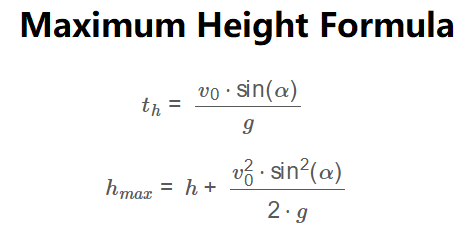1. What is a Maximum Height Calculator – Projectile Motion?
Definition: This calculator determines the maximum height reached by a projectile during its flight, given its initial velocity, launch angle, and initial height.
Purpose: It is used in physics to analyze the vertical motion of projectiles, such as a ball thrown at an angle, aiding in understanding projectile motion principles.
2. How Does the Calculator Work?
The calculator uses the following formulas:
Time to Reach Maximum Height:
\[
t_h = \frac{v_0 \cdot \sin(\alpha)}{g}
\]
Maximum Height:
\[
h_{max} = h + \frac{v_0^2 \cdot \sin^2(\alpha)}{2 \cdot g}
\]
Where:
- \( h_{max} \): Maximum height (cm, m, in, ft, yd, km, mi)
- \( v_0 \): Initial velocity (m/s, km/h, ft/s, mph, kn, ft/min)
- \( \alpha \): Angle of launch (degrees, radians)
- \( h \): Initial height (cm, m, in, ft, yd, km, mi)
- \( g \): Acceleration due to gravity (\( 9.81 \, \text{m/s}^2 \))
Unit Conversions:
- Velocity Units (v₀): m/s, km/h, ft/s, mph, kn, ft/min
- Angle Units (α): degrees, radians
- Height Units (h, h_max): cm, m, in, ft, yd, km, mi
Steps:
- Enter the initial velocity (v₀), selecting the unit (m/s, km/h, ft/s, mph, kn, ft/min)
- Enter the angle of launch (α), selecting the unit (degrees, radians)
- Enter the initial height (h), selecting the unit (cm, m, in, ft, yd, km, mi)
- Convert all inputs to SI units (m/s, radians, m)
- Calculate the maximum height using the formula
- Select the desired unit for the maximum height and view the result
3. Importance of Maximum Height Calculation
Calculating the maximum height of a projectile is crucial for:
- Physics Education: Understanding the vertical component of projectile motion.
- Sports and Ballistics: Analyzing the trajectory of balls in sports or projectiles in ballistics.
- Safety Analysis: Predicting the peak height of objects to ensure safety in scenarios like fireworks or thrown objects.
4. Using the Calculator
Examples:
- Example 1: For an initial velocity \( v_0 = 25.36 \, \text{m/s} \), angle \( \alpha = 12^\circ \), initial height \( h = 25 \, \text{m} \):
- Angle in radians = \( 12 \times \frac{\pi}{180} = 0.2094 \, \text{rad} \)
- \( \sin(\alpha) = \sin(0.2094) = 0.2079 \)
- Maximum height contribution = \( \frac{(25.36)^2 \cdot (0.2079)^2}{2 \cdot 9.81} = \frac{643.13 \cdot 0.0432}{19.62} = 1.416 \, \text{m} \)
- Total maximum height = \( 25 + 1.416 = 26.416 \, \text{m} \)
- Displayed as 26.416 m (rounded to 3 decimal places)
- Example 2: For an initial velocity \( v_0 = 50 \, \text{mph} \), angle \( \alpha = 45^\circ \), initial height \( h = 10 \, \text{ft} \):
- Velocity in m/s = \( 50 \times 0.44704 = 22.352 \, \text{m/s} \)
- Angle in radians = \( 45 \times \frac{\pi}{180} = 0.7854 \, \text{rad} \)
- Height in m = \( 10 \times 0.3048 = 3.048 \, \text{m} \)
- \( \sin(\alpha) = \sin(0.7854) = 0.7071 \)
- Maximum height contribution = \( \frac{(22.352)^2 \cdot (0.7071)^2}{2 \cdot 9.81} = \frac{499.61 \cdot 0.5}{19.62} = 12.727 \, \text{m} \)
- Total maximum height = \( 3.048 + 12.727 = 15.775 \, \text{m} \)
- In ft = \( 15.775 \times 3.28084 = 51.775 \, \text{ft} \)
5. Frequently Asked Questions (FAQ)
Q: What is the maximum height in projectile motion?
A: The maximum height (\( h_{max} \)) is the highest vertical position a projectile reaches during its trajectory, calculated as \( h_{max} = h + \frac{v_0^2 \cdot \sin^2(\alpha)}{2 \cdot g} \).
Q: Why is the vertical velocity zero at the maximum height?
A: At the maximum height, the projectile stops rising and begins to fall, so its vertical velocity becomes zero (\( v_y = 0 \)).
Q: What happens if the launch angle is 0°?
A: If \( \alpha = 0^\circ \), the projectile moves horizontally, and the maximum height is equal to the initial height (\( h_{max} = h \)).
Maximum Height Calculator – Projectile Motion calculator with Angle© - All Rights Reserved 2025
 Home
Home
 Back
Back
